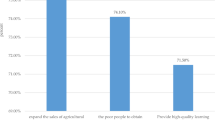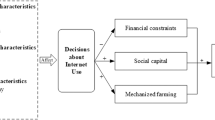Abstract
With increased focus on survival strategies for small farm businesses, we investigate the impact of access to the Internet on household income and expenses of small farm businesses and households. Using a nationwide data from the U.S. and non-parametric matching estimators, the study finds a significant positive impact of access to the Internet on total household income and off-farm income. Our study suggests that small farm businesses benefit from Internet access as it increases business income, off-farm income and total household income. Also, access to the Internet reduces some input costs and household expenses.
Similar content being viewed by others
Notes
Gross cash farm income is the sum of the farm’s cash and marketing contract revenues from the sale of livestock and crops. It includes all farm-related revenue, not just crop and livestock sales, and is based on annual sales, not the value of annual production.
Further, in addition to other reasons for Internet adoption, Mishra et al. [25], studying farm business households, point out that the Farm Service Agency, a major provider of farm program payments to farmers, has about 78 farm program forms available online for farmers to complete and submit electronically via the Internet.
Total household income is composed of off-farm income and farming income. Total off-farm income includes income from wages and salaries, off-farm business income, and income from non-earned sources.
It should be pointed out that most existing studies have explored Internet applications, purchasing patterns, and factors influencing Internet adoption.
The financial measures used in this study are (1) incomes: total household income, total off-farm income, gross cash farm income, and net farm income; (2) cost: total variable costs, marketing and storage cost, fertilizer and chemical cost, and utilities, household supplies, and other household expenses.
Recall total household income is composed of income from both off-farm sources and farm sources.
Table 3 Estimates of the average treatment effect on treated (ATT)
References
Abadie, A., & Imbens, G. W. (2002). Simple and bias-corrected matching estimators for average treatment effects. Cambridge, MA: T0283, National Bureau of Economic Research Inc.
Abadie, A., Drukker, D., Herr, J. L., & Imbens, G. W. (2004). Implementing matching estimators for average treatment effects in stata. Stata Journal, 4, 290–311.
Alam, S. S., & Noor, M. K. M. (2009). ICT adoption in small and medium enterprises: An empirical evidence of service sectors in Malaysia. International Journal of Business and Management, 4(2), P112.
Batte, M. T. (2004). Computer adoption and use by Ohio farmers. Journal of American Society of Farm Managers and Rural Appraisers, 67(1), 108–111.
Batte, M. T. (2005). Changing computer use in agriculture: Evidence from Ohio. Computers and Electronics in Agriculture, 47, 1–13.
Becker, S. O., & Ichino, A. (2002). Estimation of average treatment effects based on propensity scores. Stata Journal, 2, 358–377.
Briggeman, B. C., & Whitacre, B. E. (2010). Farming and the internet: Reasons for non-use. Agricultural and Resource Economics Review, 39(3), 571–584.
Cameron, A. C., & Trivedi, P. K. (2005). Microeconometrics: Methods and applications. Cambridge, NY: Cambridge University Press.
Chang, H., & Just, D. R. (2009). Internet access and farm household income: Empirical evidence using semi-parametric assessment in Taiwan. Journal of Agricultural Economics, 60(2), 348–366.
Cherif, E., & Grant, D. (2013). Analysis of e-business models in real estate. Electronic Commerce Research, 13 Online. doi:10.1007/s10660-013-9126-z.
Dasgupta, P., & Sengupta, K. (2002). E-commerce in the Indian insurance industry: Prospects and future. Electronic Commerce Research, 2(1–2), 43–60.
Deakins, D., Mochrie, R., & Galloway, L. (2004). Rural business use of information and communications technologies: A study of the relative impact of collective activity in rural Scotland. Strategic Change, 13, 139–150.
Dholakia, R. R., & Kshetri, N. (2004). Factors impacting the adoption of the internet among SMEs. Small Business Economics, 23(4), 311–322.
Dubman, R. W. (2000). Variance estimation with USDA’s farm costs and returns surveys and agricultural resource management study surveys. Staff paper no. AGES00-01 resource economics division. Washington, DC: Economic Research Service, U.S. Department of Agriculture.
García-Murillo, M. (2004). Institutions and the adoption of electronic commerce in Mexico. Electronic Commerce Research, 4(3), 201–219.
Gloy, B. A., & Akridge, J. T. (2000). Computer and internet adoption in large U.S. farms. International Food and Agribusiness Management Review, 3, 323–338.
Gökmen, A. (2012). Virtual business operations, e-commerce & its significance and the case of Turkey: Current situation and its potential. Electronic Commerce Research, 12(1), 31–51.
Henderson, J., Doley, F., Akridge, J., & Carerre, A. (2005). Adoption of internet strategies by agribusiness firms. International Food and Agribusiness Management Review, 8(4), 42–61.
Hoppe, R. A., McDonald, J. M., & Korb, P. (2010). Small farms in the United States: Persistence under pressure. Washington, DC: Economic Information Bulletin Number 63, Economic Research Service, U.S. Department of Agriculture.
Jennex, M. E., Amoroso, D., & Adelakun, O. (2004). E-commerce infrastructure success factors for small companies in developing economies. Electronic Commerce Research, 4(3), 263–286.
Khandker, S. R., Koolwal, G. B., & Samad, H. A. (2010). Handbook on impact evaluation: Quantitative methods and practices. Washington, DC: The World Bank.
Martin, L. M., & Matley, H. (2003). Innovative use of internet in established small firms: The impact of knowledge management and organizational learning in accessing new opportunities. Qualitative Market Research: An International Journal, 6(1), 18–26.
McFarlane, D., Chembezi, D., Befecadu, J. (2003). Internet adoption and use of e-commerce strategies by agribusiness firms in Alabama. Working Paper SFRC-03., Small Farms Research Center, Alabama A&M University. Selected Paper, Southern Agricultural Economics Association annual meeting, Mobile, AL, Feb 1–5, 2003.
Mishra, A. K., & Park, T. A. (2005). An empirical analysis of internet use by U.S. farmers. Agricultural and Resource Economics Review, 34(2), 253–264.
Mishra, A. K., Williams, R. P., & Detre, J. D. (2009). Internet access and internet purchasing patterns of farm households. Agricultural and Resource Economics Review, 38(2), 240–257.
Mishra, A., Morehart, M., El-Osta, H., Johnson, J., & Hopkins, J. (2002). Income, wealth, and well-being of farm operator households. Washington, DC: Agricultural Economics Report No. 812, U.S. Department of Agriculture, Economic Research Service.
Mishra, A. K., El-Osta, H. S., & Steele, C. J. (1999). Factors affecting the profitability of limited resource and other small farms. Agricultural Finance Review, 59(6), 77–91.
Narayanasamy, K., Rasiah, D., & Tan, T. M. (2011). The adoption and concerns of e-finance in Malaysia. Electronic Commerce Research, 11(4), 383–400.
Obiri-Yeboah, K., Owusu-Ansah, W., & Odei-Lartey, E.O. (2013). Factors that drive internet usage among small and medium scale enterprises: evidence from Ghana. International Journal of Management & Marketing Research, 6(2).
Putler, D. S., & Zilberman, D. (1988). Computer use in agriculture: Evidence from Tulare County, California. American Journal of Agricultural Economics, 70(4), 790–802.
Robison, L., & Barry, P. (1987). The competitive firm’s response to risk. New York: McMillian Publishing Company.
Rosston, G., Savage, S., & Waldman, D. (2011). Household demand for broadband Internet service. Communications of the ACM, 54(2), 29–31.
Savage, S. J., & Waldman, D. M. (2009). Ability, location, and household demand for internet bandwidth. International Journal of Industrial Organization, 27, 166–174.
Sevilla, C. (2014). The Benefits of Internet-Enabled Trade in Small Business. Office of United States Trade Representative. http://www.ustr.gov/about-us/press-office/blog/2014/january/Benefits-of-internet-enabled-trade-to-small-business. Accessed March 2014.
Sila, I. (2013). Factors affecting the adoption of B2B e-commerce technologies. Electronic Commerce Research, 13(2), 199–236.
Solaymani, S., Sohaili, K., & Yazdinejad, E. A. (2012). Adoption and use of e-commerce in SMEs. Electronic Commerce Research, 12(3), 249–263.
Stenberg, P., Morehart, M., Vogel, S., Cromarti, J., Breneman, V., & Brown, D. (2009). Broadband Internet’s value for rural America. Research report no.: 78. Washington, DC: Economic Research Service, U.S. Department of Agriculture.
Strempel, D. (2002). Small businesses expecting growth despite economy. Fairfield County Business Journal, 41(48), 2.
Suki, N. M. (2013). Consumer shopping behaviour on the Internet: Insights from Malaysia. Electronic Commerce Research, online. doi:10.1007/s10660-013-9131-2.
Uematsu, H., & Mishra, A. K. (2012). Organic farmers or conventional farmers: Where’s the money? Ecological Economics, 78, 55–62.
Warren, M. (2004). Farmers online: Drivers and impediments in adoption of Internet in UK agricultural business. Journal of Small Business and Enterprise Development, 11(3), 371–381.
Wooldridge, J. M. (2002). Econometric analysis of cross-section and panel data (1st ed.). Cambridge, MA: The MIT Press.
Author information
Authors and Affiliations
Corresponding author
Rights and permissions
About this article
Cite this article
Khanal, A.R., Mishra, A.K. & Koirala, K.H. Access to the Internet and financial performance of small business households. Electron Commer Res 15, 159–175 (2015). https://doi.org/10.1007/s10660-015-9178-3
Published:
Issue Date:
DOI: https://doi.org/10.1007/s10660-015-9178-3




